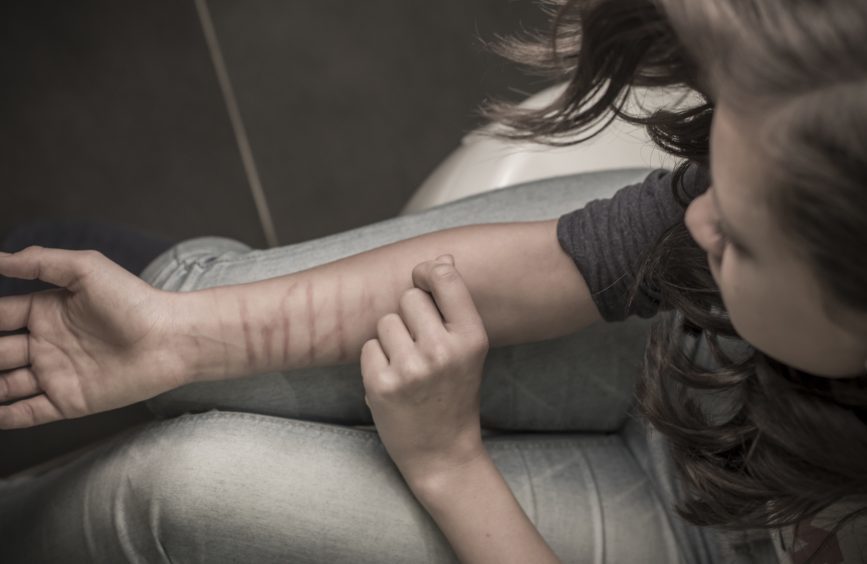As parents are warned about a self-harming craze amongst some children at a Dundee primary school, Michael Alexander looks into the rise of games that can go too far.
It’s the dangerous new self-harm ‘game’ that has seen children from a Dundee primary school slicing themselves with blades to see who can cut the deepest.
Last month letters were issued to parents of youngsters at Craigowl Primary in St Mary’s to warn them about the challenge – which appears to have started in America – and which sees the child with the deepest cuts being declared the winner.
It has echoes of another disturbing craze called the ‘eraser challenge’ reported recently from the USA which involves children in school being encouraged to recite the alphabet while rubbing pencil erasers on their skin until it peels away and bleeds.
Children are encouraged to post photographs of their wounded skin on social media and the person with the deeper wound or burn-like mark is hailed the ‘winner’.
Youngsters have, of course, always gone in for dares –-and most, you would hope, know where to draw the line.
‘Chappy-knocky’ was a perennial favourite back in the day, whilst in the 1980s it wasn’t unknown for children to climb trees and then deliberately drop themselves through the canopy of branches in an innocent yet potentially bone snapping game of ‘stunt men’ inspired by watching Colt Seavers on the Fall Guy.
What does seem to have changed, in recent years, however, is the potential for ‘crazes’ to go wrong – and it seems the trend is being fuelled by social media.
https://www.youtube.com/watch?v=eWnJ5Sng3QY
Two years ago, for example, skin experts warned against a new craze where teenagers spray aerosol deodorant onto their skin at close range.
Teenagers then pressed and held the aerosol to the skin for as long as possible – and tried to outdo each other to see who can endure it for the longest.
A warning was also issued recently about another dangerous new craze sweeping schools whereby children as young as 12 were risking their lives by hanging themselves until they almost pass out.
Then several weeks ago there was a warning from Kinross-based PC Atholl Spalding of Police Scotland about a sinister new Facebook craze whereby children may deliberately go missing for up to 48 hours to see how much Facebook traffic they can generate.
The warning was sounded after a 14-year-old Fife schoolgirl was discovered safe and well after being reported missing.
Fife secondary school teacher David Farmer, who is also press officer for the Fife branch of Scotland’s largest teaching union the EIS, says most of the crazes he has experienced in school involve “annoyances” like Fidget Spinners.
Others, like a video upload of pupils at Levenmouth Academy jumping into lockers, could be viewed as just “plain daft” or, as another teacher put it, “side splittingly funny”.
However, Mr Farmer adds there’s no doubt that social media – which is now a fact of life – can encourage some of the more dangerous activities.
While children can and do use social media responsibly, schools have a moral duty to protect young people from situations where they might not have thought through the potential consequences.
“When the teenager died after ‘tomb stoning’ into the water filled quarry at Inverkeithing a couple of years ago, it was something that head teachers picked up on because it posed a risk to kids in that area,” he said.
“Schools have a responsibility – not in a statutory sense but in a moral sense – to protect kids in school.
“But a lot of things that appear on social media have a short shelf life. The immediacy of social media means it’s not about keeping up but moving on to the next thing.
“When I was a teenager the idea that you could do something daft, film it, and send it round the world would be impossible.
“Today, schools have a duty to help educate and think about the consequences. You see a lot of issues online about ‘grooming’ – an issue where kids can be quite naïve.
“I don’t mean that in a disrespectful way just that they lack life experience. It’s easier for them to be drawn in where adults might take a step back and say ‘what’s this all about?’
“It’s the same with some of these crazes. At the same time, you are never going to stop kids doing daft things and nor should it be – that’s what being a kid is about. The best you can hope for is to prepare kids to deal with situations when they arise and make the right choices.”
One Central Fife teacher claimed his school was “less crazes and more crazy!”
He said: “Here the kids are more interested in extreme traditional pass times such as truanting, smoking , wandering, being abusive and bullying/assaulting one another. I think the majority of crazes are too organised for our kids.”
However, another teacher said: “I think most of the kids I’ve taught are either too sensible or too scared to actually do it.
“The real problem with it is that because it’s on social media a lot of it now runs under the radar of schools and teachers.”










